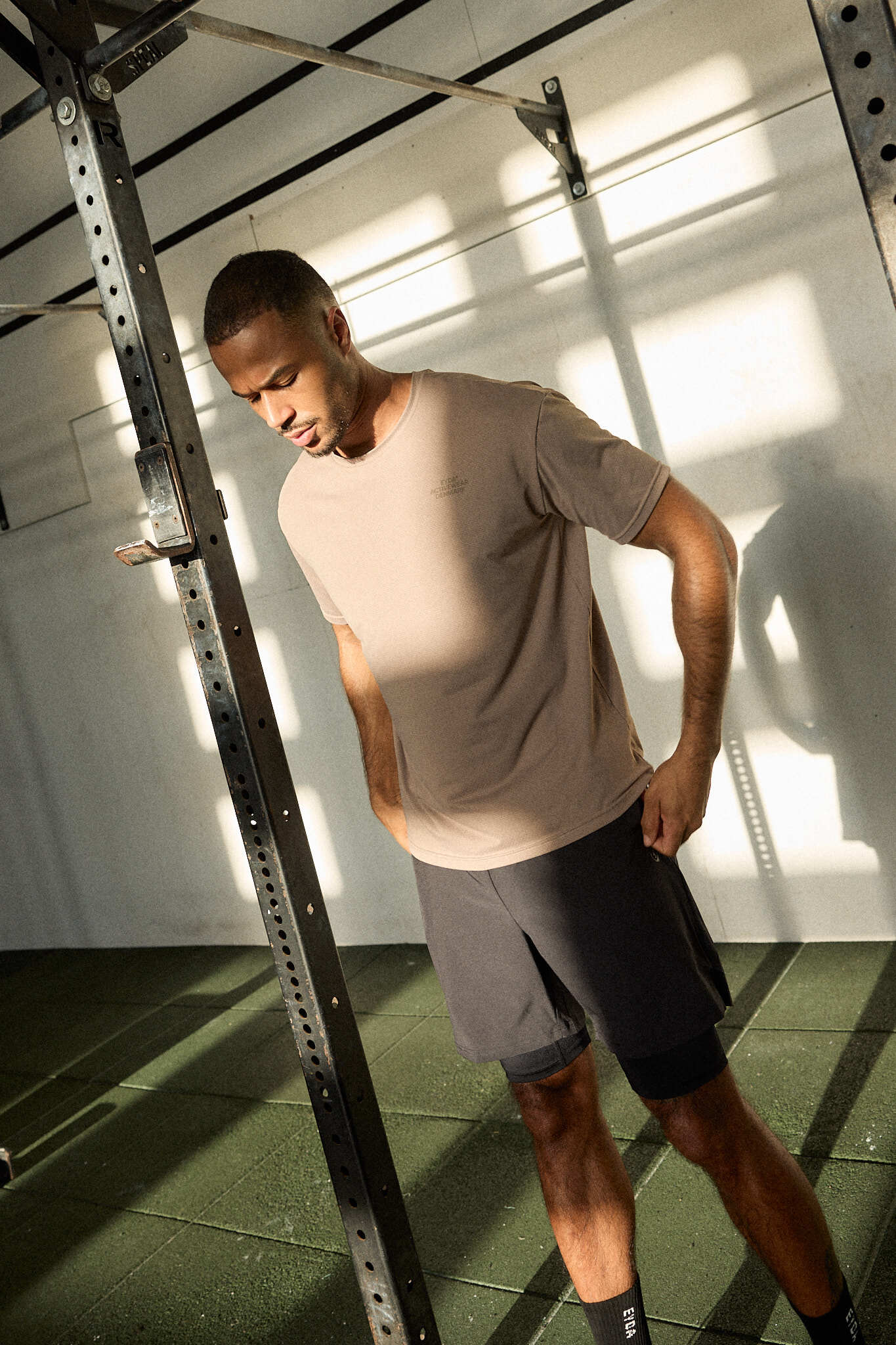Embrace
your cycle

We've asked women's health and training expert Emma Kaalund how the menstrual cycle impacts our training and how we can make our training routines more self-compassionate. Here, she shares her insights on adjusting workouts to align with the hormonal fluctuations that occur throughout the cycle, helping you achieve balance, well-being, and optimal performance.
KNOW YOUR CYCLE AND ITS IMPACT ON YOUR TRAINING
The female menstrual cycle influences a woman's hormone levels, energy expenditure, and therefore performance when it comes to training. The cycle typically lasts between 21 and 35 days and is divided into two phases: the follicular phase and the luteal phase. These phases are characterized by fluctuations in the two primary hormones, estrogen and progesterone, which play a role in how the body responds to exercise.
The follicular phase (days 1-14) - Bring it on!
The follicular phase begins on the first day of menstruation and lasts until ovulation around day 14. In this phase, estrogen levels gradually increase as the follicle that’s maturing the egg releases estrogen. Progesterone remains low during this time, and these hormonal changes can positively influence muscle growth, recovery, and energy levels. Many women may feel more energetic, experience higher motivation, and perform better physically during this phase. Additionally, the high levels of estrogen boost leptin production, which promotes feelings of fullness. Therefore, you may find yourself feeling less hungry toward the end of this phase.
Once the follicle is fully developed, it bursts due to the pressure of the follicular fluid, releasing the egg. This is ovulation. The egg is then transferred to the fallopian tube. While ovulation isn’t a separate phase, it marks the transition between the follicular and luteal phases. Some women may experience lower abdominal pain during ovulation, known as ovulation pain, which is caused by the slight bleeding that occurs when the follicle bursts and irritates the peritoneum. This pain generally subsides within a few hours.
The luteal phase (days 15-28) - Where’s my chocolate?
The luteal phase starts after ovulation and lasts until the next menstruation. After ovulation, the cells in the follicle wall transform into the corpus luteum, a hormone-producing gland. The corpus luteum produces progesterone, and during this phase, estrogen levels decrease while progesterone levels rise significantly. Progesterone can have several effects, such as raising body temperature and increasing metabolism, which can lead to a rise in energy expenditure by about 100-300 calories. However, appetite also increases accordingly, which can lead to overeating.
This behavior can be further amplified by progesterone lowering insulin sensitivity, leading to larger blood sugar swings that can cause cravings. Many women also experience premenstrual symptoms (PMS), such as bloating, mood swings, and fatigue, which can affect their performance.
Unlike estrogen’s effects on muscles, progesterone appears to have a more catabolic effect on muscle tissue. If pregnancy doesn’t occur, the egg will be shed, estrogen and progesterone levels will drop, and menstruation will follow.
Should training be adjusted to the cycle?
Whether you should adjust your training to your cycle largely depends on how much you train and how affected you are by your cycle. Some women are more impacted by their cycle than others, and some simply don’t train enough to warrant changing their training based on their cycle phase.
While some studies suggest that adjusting training based on hormonal changes could maximize the benefits of the high estrogen levels in the late follicular phase, the research is often limited in quality, making it difficult to say if this remains a theoretical rationale.
However, there are studies with stronger evidence that show that performance may decline during menstruation and in the late luteal phase compared to other phases. Women also report the lowest levels of perceived physical and mental well-being just before and during menstruation.
When it comes to how you should train through a menstrual cycle for the best possible training outcomes, it’s difficult to make general recommendations. However, there are certainly aspects of the body’s response to the menstrual cycle that could be worth exploring, allowing you to optimize both your training and understanding of your body:
- Track your cycle
How long is your cycle? What symptoms do you experience, and to what extent? If you notice patterns, they may likely be related to your menstrual cycle. By tracking this, you can identify whether you have cyclical variations in symptoms, energy levels, and sleep that should be factored into your daily life and/or training plan.
- Be aware of where you are in your cycle and adjust training as needed
If you experience lower energy levels - likely just before or during menstruation - it may be wise to adjust your expectations for training. Continue your training routine as much as possible, perhaps focusing on the feeling you have after working out, your improved mood, or better sleep. If you can’t stick to your usual routine, you can modify the intensity and/or volume of your workouts to match your energy levels. You could also try a different form of exercise; the key is to maintain your movement habit and find ways to enjoy your workouts while staying active.
- Find ways to feel comfortable amid the discomfort
You can make training more comfortable by wearing darker colors, which help minimize the appearance of any leaks during workouts. Additionally, change menstrual products right before working out to prevent unexpected leaks. Wearing looser clothing can also help if you experience bloating, such as during ovulation or around menstruation.
Note: When we discuss the effects of the cycle on training and whether it makes sense to adjust training according to it, we are talking about naturally menstruating women. If you use oral contraceptives like birth control pills, your response to training may differ. Birth control pills containing synthetic progesterone may potentially inhibit muscle growth in women, but these women do not generally show performance variations between the days they take the pill and the days of withdrawal bleeding.
ABOUT EMMA:
Emma Kaalund holds a Master’s degree in Sports Science from Aarhus University and is co-producer of the danish MORtion podcast, which shares evidence-based knowledge on pregnancy and postpartum training. For the past seven years, Emma has also trained pregnant women and new mothers. With a strong focus on safety and health, Emma teaches women how to achieve strength and balance at every stage of life. Her goal is to create a space where women feel safe, informed, and motivated to take control of their own health and well-being.
Sources:
Dam, T. V.; Dalgaard, L. B.; Sevdalis, V.; Bibby, B. M.; Janse De Jonge, X.; Gravholt, C. H.; Hansen, M. Muscle Performance during the Menstrual Cycle Correlates with Psychological Well-Being, but Not Fluctuations in Sex Hormones. Medicine & Science in Sports & Exercise 54(10):p 1678-1689, October 2022. | DOI: 10.1249/MSS.0000000000002961
Elliott-Sale, K.J., McNulty, K.L., Ansdell, P. et al. The Effects of Oral Contraceptives on Exercise Performance in Women: A Systematic Review and Meta-analysis. Sports Med 50, 1785–1812 (2020). https://doi.org/10.1007/s40279-020-01317-5
Kissow J, Jacobsen KJ, Gunnarsson TP, Jessen S, Hostrup M. Effects of Follicular and Luteal Phase-Based Menstrual Cycle Resistance Training on Muscle Strength and Mass. Sports Med. 2022 Dec;52(12):2813-2819. doi: 10.1007/s40279-022-01679-y. Epub 2022 Apr 26. PMID: 35471634.
McNulty, K.L., Elliott-Sale, K.J., Dolan, E. et al. The Effects of Menstrual Cycle Phase on Exercise Performance in Eumenorrheic Women: A Systematic Review and Meta-Analysis.Sports Med 50, 1813–1827 (2020). https://doi.org/10.1007/s40279-020-01319-3




